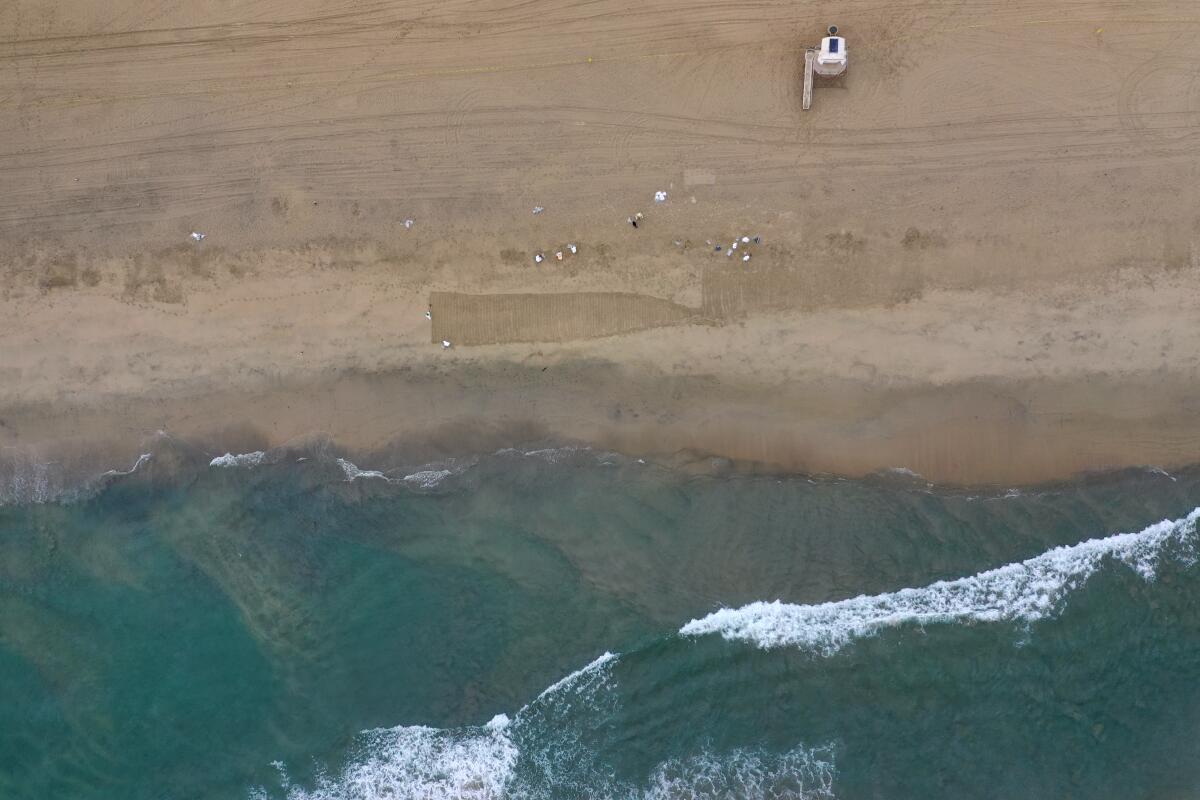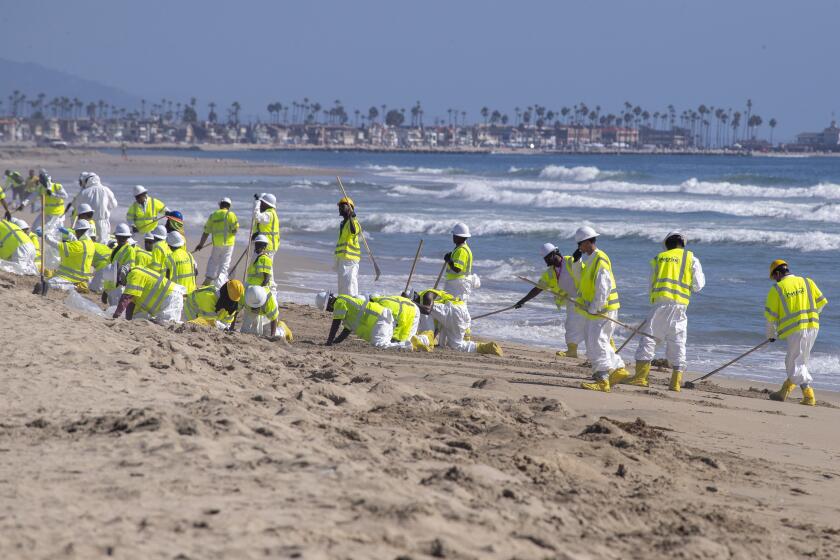Who knew about the Orange County oil spill and when?

- Share via
There are growing questions about how the first hours of the Orange County oil spill were handled, with new information showing officials first learned a slick was likely Friday night. It would not be until the following evening that officials told the public the leak was grave and about to hit local beaches.
Local officials are demanding a full accounting about when authorities learned of oil in the water and what they did about it, and many state legislators are already planning oversight hearings when they reconvene.
“We have got to get to the bottom of this and I have already had conversations with some of my colleagues at the state level,” said Assemblywoman Cottie Petrie-Norris (D-Laguna Beach). “I have a number of questions.”
A massive oil spill off the Orange County coast has fouled beaches and killed birds and marine life
“Quite frankly these kinds of incidents should have been made known to us before they were made public because our constituents will have questions,” Assemblywoman Janet Nguyen, whose district also has been hit with oil on its beaches, said.
Here a timeline based on what we know:

Friday
- Beginning in the afternoon and evening, residents in both Huntington Beach and Newport Beach begin smelling a strong odor. Some called authorities to report it. Newport Beach Police Department’s phones started ringing with residents throughout the city reporting the smell of gas. Police received more than 20 inquiries, and the department sent out a community advisory about 7:45 p.m. saying authorities were checking it out.
- Jogging along the packed Huntington Beach boardwalk Friday evening, Hal Lopez remembers smelling something “kinda like rotten, old meat maybe? I didn’t know what was going on and had to stop running; I have a very sensitive nose.” Neal Shehab, who lives in Newport Shores, also started to smell oil fumes Friday night. “We didn’t know what it was,” he said.
- The Office of Spill Prevention and Response, a division of the California Department of Fish and Wildlife charged with handling such emergencies, said in a report obtained by The Times that it was first notified of an “observed sheen in federal waters several miles off the coast of Huntington Beach” on Friday at 10:22 p.m., though the source and volume were unknown. An incident form obtained from Cal OES lists the call coming in at 8:22 p.m. That report was based on information provided to California authorities by the National Reporting Center, the designated point of contact for all oil and chemical discharges into the environment, which took a report about a possible spill earlier Friday night, according to documents reviewed by The Times. Records show that the National Reporting Center informed the state’s Office of Emergency Services that a ship had reported a possible oil slick about 5 miles west of Huntington Beach on Friday evening. Satellite imagery was used to take a closer look about 45 minutes after the report, measuring the spill at about 3.2 miles long and nearly a mile wide. While the satellite images could not definitively identify the substance as oil, the report said the overhead imagery allowed for “high confidence” that it was petroleum. The report also said the spill extended beyond the borders of the image and could be larger.
- Shortly after, federal and state authorities began to mobilize, forming a command center to handle the emerging crisis. But darkness likely prevented them from examining the slick up close.

Saturday
- The owner of the platform and pipe where the leak occurred reported it to authorities in the morning. Martyn Willsher, Amplify’s chief executive, said in a Monday news conference that the company did not know about the leak until Saturday. Brian Ferguson, spokesman for the Office of Emergency Services, which acts as the receiver for spill reports for the state, said his agency was notified by representatives for Amplify Energy — the company that owns the aging infrastructure — at 8:55 a.m. Saturday that a pipeline leak had occurred that morning, and was noted by workers at about 2:30 a.m. A report of the incident describes the leak as involving a 16-inch pipe associated with the Elly platform, and said the pipeline had been “shut” but containment was unknown.
- The Coast Guard said it received an initial report of an oil sheen at 9:10 a.m. Documents obtained by The Times show in addition to the initial Amplify report, another report was received shortly after 10 a.m. that sheen had been spotted under Eva, the platform near Elly, and was moving east toward the coast.
- Dylan Bartell, 17, who was out with his father on their fishing boat, said he was below deck around 9 a.m. when his father called him up to see oil surrounding their boat, the Babe Del Mar. Visibility was bad, but they were about nine miles offshore heading toward Catalina. “We could see that it went on for miles, and there was just thick oil beneath us,” Bartell said. He and his father radioed the Coast Guard but did not receive an immediate response, so the teenager googled how to report an oil spill and called it in to authorities. Later, a second radio attempt to the Coast Guard received a response, with authorities telling Bartell they had already received other reports, he said. Bartell’s report was forwarded to Cal OES Saturday at 9:17 a.m.
- Newport Beach Mayor Brad Avery was sailing in from Avalon about 11:30 a.m. when he came across the spill. Other boaters had reported it on the marine radio as they passed over the slick, he said. “As we got within about five miles of the coastline, all of the sudden we were going through this major oil slick,” he said. “We had a pod of dolphins on our bow as we were going through it. Of course we couldn’t signal to them to change direction, but they seemed to make it through OK.”
- Shortly after noon, the Coast Guard announced on Twitter that it was responding to a large oil slick. It was the first public announcement of a spill.
- Then, late Saturday afternoon, a Coast Guard official told The Times: “We were alerted quickly. We really believe we will keep this to a small contained incident.” The city of Newport Beach sent out a tweet around that time saying the spill should dissipate through wind, sun and wave action and was not expected to come ashore.
- Around 8 p.m. Saturday, it was clear the oil spill had the potential to become a major disaster. It remains unclear why it took so long to determine the gravity of the situation. Huntington Beach officials and other local leaders announced the closure of beaches and said oil was beginning to hit the coastline. Workers spent the night and morning trying to prevent oil from getting into wetland areas.
- Oil began washing ashore soon after.

Sunday
- Early Sunday morning, officials canceled the last day of the popular Pacific Airshow in Huntington Beach.
- By sunrise, it became clear that oil had entered Talbert Marsh and other wetland areas of Huntington Beach. Crews work to keep as much oil as possible out of ecologically sensitive areas.
Monday
- The oil plume moved south, with Laguna Beach seeing pockets of oil washing ashore. By nightfall, part of the oil plume was moving toward Dana Point and into waters off San Diego County.
- Officials said they were investigating whether a ship anchor had ruptured an undersea oil pipeline, causing the spill.
- The estimated size of the spill increased from 126,000 gallons to 141,000 gallons.
More to Read
Sign up for Essential California
The most important California stories and recommendations in your inbox every morning.
You may occasionally receive promotional content from the Los Angeles Times.



















